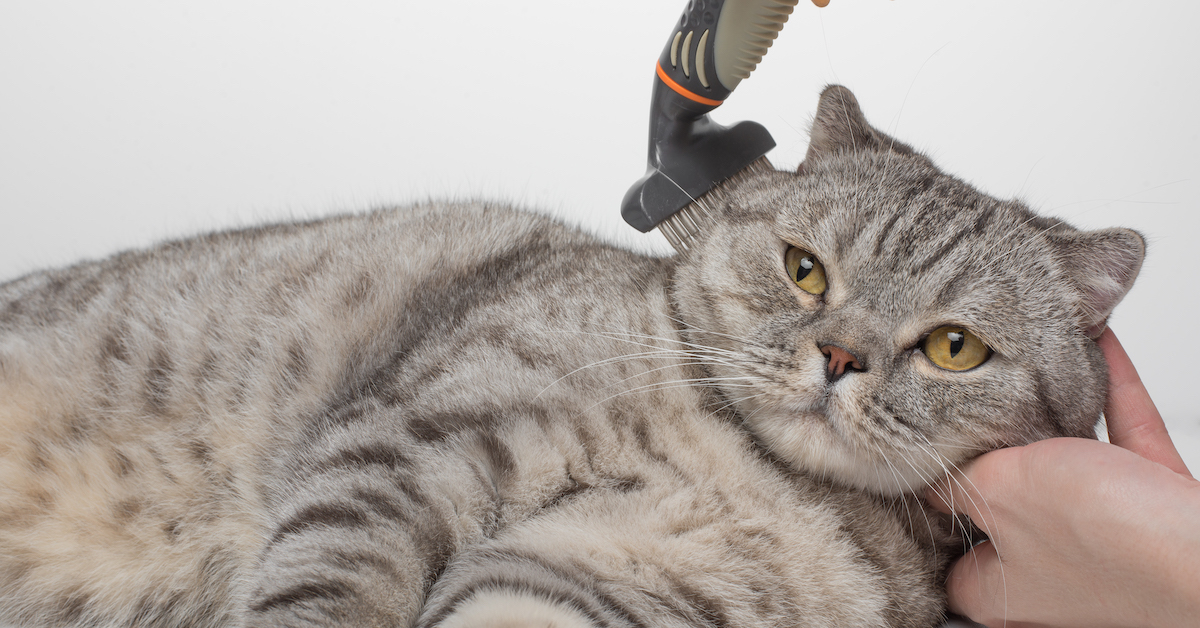5 Misconceptions About Hairballs in Cats
Cats hacking up hairballs is a common occurrence that has resulted in many misconceptions.

If you’ve ever owned a cat, you’ve likely encountered a hairball or two. Although they can be an unwelcome surprise, the presence of hairballs simply indicates that your pet has healthy grooming habits.
A hairball is a collection of hair and digestive juices created when your cat grooms herself and swallows the hair. Not all hair that your cat ingests will pass through the intestinal tract, and instead, will create a “ball” in the stomach.
When a cat tries to bring up the hairball, it may retch, gag, or appear as if they are dry heaving. Vomiting up hairballs is important to prevent them from entering the intestine and causing a blockage.
While hairballs in cats are completely normal, there are many misconceptions about this behavior. Let's debunk some of these common myths and learn what’s normal and what’s not normal when it comes to hairballs.
1. Hairballs are Shaped Like Balls
With a name like ‘hairball’, you would assume that a hairball would have a ball-like shape. In reality, most hairballs are not actually shaped like balls. Instead, they more resemble sausages as they are long, cylindrical, and dense. The average hairball is about the width of your thumb, although they can vary in size depending on the amount of hair swallowed.
The reason for this sausage-like shape is due to the way in which hair accumulates in the stomach. As your cat grooms herself over days, hair gathers in the stomach and begins to wad together. Once the hairball becomes large enough to be expelled from the body, it moves back up the digestive and respiratory systems and into the mouth. It is easier for the body to remove a sausage-shaped object than a ball-shaped object.
2. Hairballs Cause Coughing
It is a common misconception that hairballs cause coughing. Coughing is the body’s way of responding to an irritant in the throat or airways. When an irritant stimulates the nerves, it sends a message to the brain which induces coughing. Hairballs in cats do not cause coughing but instead induce vomiting.
Your cat may seem like she’s coughing as she assumes a crouching position and makes sounds similar to coughing. However, she is actually vomiting up the wad of hair from her stomach. If your cat is coughing, it may be due to other issues like feline asthma, heartworm, allergies, respiratory infection, pneumonia, or a parasitic condition.
When your cat appears to be coughing, pay attention to what comes next. If there is no hairball after the coughing fit, the problem likely isn’t hairballs. If the coughing continues, consider bringing your pet to see a veterinarian for a proper diagnosis and treatment plan.
3. Only Long-Haired Cats Get Hairballs
If you adopt a short-haired feline, you may believe you’re in the clear. The truth is that even short-haired cats can experience hairballs. In many cases, hair swallowed by cats will pass through the intestines and into the litter box, just like ordinary food. However, when gastrointestinal issues develop, the digestive tract can slow down, preventing hair from making its way through.
Hairballs can develop regardless of the length of hair as this behavior has less to do with hair length and more to do with how hair moves through the digestive system. If your cat continues to experience frequent hairballs or if the hair is combined with food, it is a good idea to visit your vet to determine if your pet is experiencing an underlying medical condition.
4. All Vomiting in Cats Is Caused by Hairballs
Finding your cat vomiting in the corner of a room is not usually a cause for concern but the issue should be monitored. Many pet owners assume that if their cat is vomiting, hairballs are the culprit. Although hairballs frequently appear with vomit, it may not be the reason your cat is throwing up. If your cat vomits regularly, it may be time to look for another reason.
Cats may vomit for a wide range of reasons. Some vomit when they eat too much or too quickly. Certain conditions can also cause your cat to vomit, such as poisoning, diabetes, food allergies, hyperthyroidism, intestinal foreign bodies, inflammatory bowel disease, and metabolic disorders. If your cat is experiencing repeated bouts of vomiting, contact your vet for guidance.
5. Hairballs in Cats are Completely Normal
It is true that the occasional hairball in cats is usually nothing to worry about. However, when hairballs become frequent or occur with other symptoms, it could be due to an underlying problem. Hairballs can sometimes occur due to gastrointestinal problems, such as gastrointestinal cancer. Other causes include inflammatory bowel disease and food intolerance.
Frequent hairballs can also be caused by over-grooming in cats. Overgrooming can have a variety of causes, such as allergies, stress, external parasites, and certain skin disorders like ringworm or auto-immune skin diseases. In some cases, pain can cause overgrooming in cats. Your cat may lick their abdomen if they are suffering from a urinary tract infection or their joints if they have arthritis.
Hairballs can be a major nuisance for cat owners, especially if they occur frequently. One of the best ways to prevent hairballs is to groom your cat on a regular basis to remove loose fur and reduce the amount of hair that your cat ingests during grooming. Grooming your cat also allows you to spend more time with your pet each day which promotes positive bonding.
Ready to start saving money on pet wellness care?
Then take a look at Mint Wellness, the pet wellness plan that provides fast reimbursement on routine pet care. Save on vaccinations, wellness exams, preventatives, dental, and more!
Learn More


